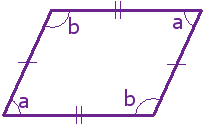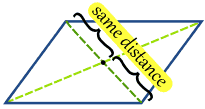Parallelogram
A Parallelogram is a flat shape with opposite sides parallel and equal in length.

| and || show equal sides
| Opposite sides are parallel | |
Opposite sides are equal in length
| |
| Opposite angles are equal (angles "a" are the same, and angles "b" are the same) | |
| Angles "a" and "b" add up to 180°, so they are supplementary angles. |
Play with a Parallelogram:
Q
Example:
A parallelogram where angles "a" and "b" are right angles
is a rectangle!
|
Area of a Parallelogram
 |
The Area is the base times the height:
Area = b × h
(h is at right angles to b)
|
Example: A parallelogram has a base of 6 m and is 3 m high, what is its Area?
Area = 6 m × 3 m = 18 m2
Perimeter of a Parallelogram
The Perimeter is the distance around the edges.
 |
The Perimeter is 2 times the (base + side length):
Perimeter = 2(b+s)
|
Example: A parallelogram has a base of 12 cm and a side length of 6 cm, what is its Perimeter?
Perimeter = 2 × (12 cm + 6 cm) = 2 × 18 cm = 36 cm
Diagonals of a Parallelogram
 |
The diagonals of a parallelogram bisect each other.
In other words the diagonals intersect each other at the half-way point.
|